Archives
-

July-December
Vol. 6 No. 2 (2025)Foreword
This issue strives to have a balanced approach of qualitative and quantitative methods on a variety of topics, including tourism narratives, Climate Smart Agriculture, brand image, co-working spaces, talent in the New Energy Vehicle (NEV) sector, and Self-Regulated Learning (SRL) in the context of ASEAN and the region.
Nick Alfred Umadhay, Sunny Gabinete from the Philippines, and Jitlada Piyatat from Thailand explore the holiday-tourism narratives of ASEAN students in Thailand with the Descriptive Phenomenological Method. Iterative coding and thematic synthesis reveal six themes, indicating that holiday tourism extends beyond recreation, serving as an informal intercultural classroom and a means of fostering ASEAN identity.
Napat Kamthonsiriwimol et al. review the current situation of rice production in Thailand and the problems of Greenhouse Gas (GHG) emissions. They present the key dimensions of Climate Smart Agriculture (CSA) and its practice and impact in Vietnam, Malaysia, and Thailand. Challenges and opportunities for CSA Implementation in Thailand’s rice production are analyzed for recommendations to key stakeholders.
Rithsereyvath Hang and Akaraphun Ratasuk expand the Stimulus-Organism-Response (S-O-R) model in the case of boutique hotels in Siem Reap, Cambodia, demonstrating the pivotal mediating role of perceived value. They suggest boutique hotel managers should strategically focus on pricing, atmosphere, CSR, and CRM initiatives to enhance perceived value and strengthen brand image.
Veerisa Chotiyaputta et al. examine the influence of space creativity on Entrepreneurial Opportunity Recognition and Exploitation (EORE) within co-working spaces in Thailand, with particular attention to the mediating role of social climate, based on survey data collected from 350 individuals in the Bangkok metropolitan area. The findings advance theory by integrating physical and social dimensions of entrepreneurial ecosystems under the Thai context.
Chao Wang and Ruyao Zheng from China study the talent supply and demand in the New Energy Vehicle (NEV) sector in Nanning, an emerging inland hub of the country. They identify acute skill polarization—specifically, surpluses in low-skilled operational roles alongside critical shortages in high-value R&D and engineering functions. A strategy of talent ecosystem development is proposed to bridge the gap between national strategic ambitions and local implementation realities.
Duangta Jaipetch, Apisara Sritulanon, and Naruemol Pechrasuwan provide a comparative analysis of secondary school curricula in Thailand, Singapore, and Malaysia, focusing on integrating Self-Regulated Learning (SRL) and life and career planning skills. Based on the findings, they propose a reform framework emphasizing SRL integration, dedicated life planning modules, enhanced cocurricular programs, teacher mentorship, and diversified assessment.
Prof. Dr. Tang Zhimin
Editor-in-Chief
-

January-June
Vol. 6 No. 1 (2025)Foreword
The contributors in this edition delve into issues of national development, consumer behavior, human resources, and education management in Thailand, Indonesia, and China.
Fikri Gali Fernando Holqi of the University of Muhammadiyah Malang, Indonesia, brings our attention to the equitable development of the country, and argues for decentralization in national development planning based on Regulatory Impact Assessment (RIA) method for public policy analysis.
Chenicha Praphruetmon et al. of PIM and Bangkok University explore User-Generated Content (UGC) in social media for Generation Z with SEM (Structural Equation Model) including perception on UGC, brand attitude, and purchase intention. Chenyi Pan and Akaraphun Ratasuk of PIM study the revisit intention of snorkeling tourists for destinations in Hainan Province, China, using PLS-SEM combined with the Sobel test for mediation.
Pithoon Thanabordeekij of Chiang Mai University applies an extension of the Theory of Planned Behavior (TPB) to capture the Influence of “Korean Wave” on consumption of an iconic Korean spirit by Thai consumers.
Xiaobo Xu of Dhurakij Pundit University diagnoses work stress and burnout among Human resources personnel in private higher education Institutions in Yunnan Province, China.
A group of researchers from Krirk University, Assumption College Rayong, and PIM propose academic administration guidelines for global citizenship and cultural Understanding within the ASEAN community, using the modified Priority Needs Index (PNI) for quantitative analysis and content analysis for qualitative data.
Prof. Dr. Tang Zhimin
Editor-in-Chief -
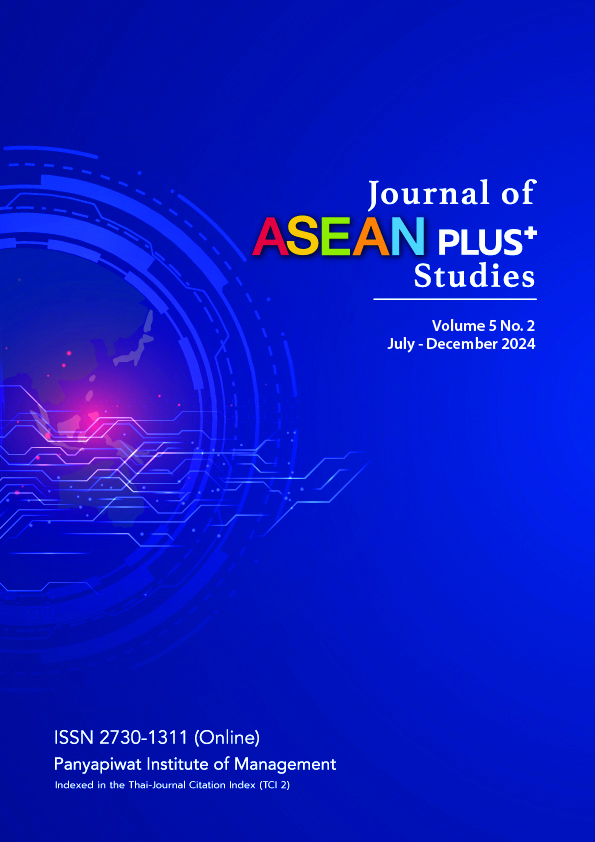
July-December
Vol. 5 No. 2 (2024)Foreword
The authors in this issue bring our attention to a variety of current topics such as: Climate Change and Food Security, Green Finance, Emotional Labor, and Consumer Behavior issues related to Acceptance and Usage, Key Opinion Consumers, and Consumer Nationalism.
Jean-Marc M. Dautrey applies a qualitative method of “discovery research” to study climate change-induced shocks as a mounting threat to ASEAN’s food and nutrition security. He calls for a transition to more sustainable, resilient, and efficient agricultural systems such as the development of organic and biodynamic techniques.
Patraranant Chinavicharana and Veerisa Chotiyaputta assess the correlation between the green loan ratio and the financial performance of three major banks in Thailand from 2018 to 2022, with a random effects model.
Xiaobo Xu explores the relationship between emotional labor and task performance, mediated by emotional regulation self-efficacy, with an online survey of 403 bank tellers in Handan City, China.
Worachart Bangyong and Jul Thanasrivanitchai adopt a modified Unified Theory of Acceptance and Use of Technology model (UTAUT2) to identify factors influencing the acceptance and usage of food delivery applications of 425 consumers in Bangkok through an online platform. The model incorporates performance expectancy, effort expectancy, social influence, facilitating conditions, hedonic motivation, price value, and habit as independent variables.
Qianjiang Zhu and Akaraphun Ratasuk surveyed 599 users of Xiaohongshu, a Social Commerce Platform in China, with stratified random sampling in Shanghai. They found the pivotal role of Key Opinion Consumers (KOC) in influencing purchase intention, together with the impacts of perceived risk and customer trust.
Anupong Thuengnaitham and Kanin Pessakul study the relationship between consumer nationalism and consumer behavior moderated by brand equity, brand awareness, and perceived quality, in the context of parcel delivery service providers in Thailand, with an online survey of 400 users.
Prof. Dr. Tang Zhimin
Editor-in-Chief -

January-June
Vol. 5 No. 1 (2024)Foreword
The authors in this issue bring our attention to a variety of current topics such as: ESG (Environmental, Social, and Governance), digital logistics, live broadcast on TikTok, creative tourism, economic downturn in Laos, and KOL (key opinion leader).
Intouch Junpong and Veerisa Chotiyaputta examine ESG and financial performance of 1,528 SET companies over the year 2020 to 2022, and test with the regression model if there is a positive significant relationship between their environmental, social & governance performance and ROE, ROA & Net Proft Margin.
Saran Phinijphara and Kritsana Lakkhongkha explore the role of digital logistics in the Eastern Economic Corridor (EEC) of Thailand, with the technologies such as cloud computing, Internet of Things (IoT), and artificial intelligence (AI), and suggest several initiatives Thailand needs to undertake.Ying Chen and
Patamaporn Pongpaibool collect data from 402 Chinese TikTok users and apply the Stimulus-Organism-Response (S-O-R) model to understand the factors affecting consumer purchase intention. The study uses professionalism, interactivity, popularity, and product involvement as independent variables, and perceived trust and playfulness as mediators,
in the PLS-SEM analysis.Thianrat Chatphattaraphona, Techita Phattharasorn, Sariya Prasertsut, and Pimmada Wichasina
design creative tourism routes in Suphanburi province of Thailand, together with a platform which
integrates information on tourist need, tourist attractions and community products available. The
results are obtained from content analysis on the interviews with government agencies, private
organizations, local communities, and Thai tourists.
Worrawoot Jumlongnark reviews the economic data in Laos from 2010-2022. The current economic downturn since 2020 is identified as the decline in GDP growth, surge in unemployment, inflation, external debt, and depreciation of Lao kip. Content analysis of 62 research articles in the period from 2001 to 2023 reveals the most prevalent sub-topics related to policy matters, followed by China’s role in foreign direct investment.Chenicha Praphruetmona and Nata Tubtimcharoonb claim “The More Familiar You Are, the Less You Will Buy” as the moderating effect of relationship strength on the continuity of viewer engagement with the KOL. The research is based on questionnaire survey of 251 respondents. SEM (structural equation modeling) reveals relationship between the suitability of KOLs, levels of relationship, viewers’ sustained engagement, and purchase intentions.
Prof. Dr. Tang Zhimin
Editor-in-Chief -
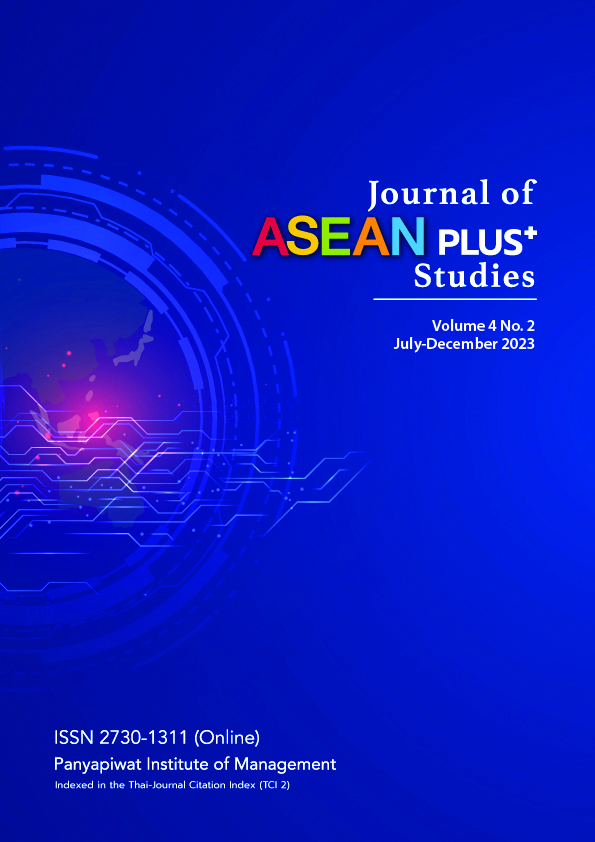
July-December
Vol. 4 No. 2 (2023)Foreword
Content-wise, scholars on this issue are interested in 1) Smart city development in Thailand; 2) Effects of the occurrence of aviation accidents; 3) Motivation and purchase/usage intention issues for customers in Cambodia (Thai facial skin care products), China (high education and wellness tourism in Thailand), and Thailand (hormonal contraception). The data analysis methods vary from qualitative content analysis to quantitative OLS regression, fxed-effect panel regression, factor analysis, cluster analysis, and PLS-SEM.
Natnicha Chotpittayanon of the College of Politics and Government, Suan Sunandha Rajabhat University, fnds the importance of smart government management and local leadership in a sustainable smart city, from a survey of 395 local government ofcials and 10 in-depth interviews. The author calls for digital infrastructure with smart city solutions.Xiangyu Liang, Benjapon Prommawin, and Pithoon Thanabordeekij of Chiang Mai University examine the impact of aviation accidents and incidents on the number of passengers. A fxedeffect panel regression model is used to analyze a dataset of 169 countries from 1970 to 2020. Prompt and transparent communication, enhanced safety standards, compensation, and support are suggested to mitigate the negative impacts.
Heang Seavmey and Sunida Piriyapada of Panyapiwat Institute of Management tested the Extended Theory of Planned Behavior (ETPB) with 200 Cambodian customers for their purchase intention of Thailand’s facial skin care products. With “Smart-PLS 4.0”, they fnd a signifcant influence of attitude, subjective norms, perceived behavioral control, the perceived value of quality, perceived cultural values and beliefs, the perceived value of price, and E-word of mouth.
Nattanun Siricharoen of Huachiew Chalermprakiet applies Content Analysis to interviews with 15 doctoral students and 43 undergraduates from China. The author fnds Chinese students are drawn to Thai universities because of their educational standards, flexible teaching methods, facilitation to break down language barriers, and potential career opportunities.
Nareeya Weerakit and Gao Jing of Prince of Songkla University explore the push and pull motivations and preferences of young wellness tourists in Chengdu, China. The cluster analysis segments a sample of 445 respondents into two groups, and the factor analysis indicates four motivational factors as “social, cultural, and environmental wellness”, “personal well-being and ftness”, “service and facility-related wellness”, and “escape”.
Kunsalyn Srinamon, Natwara Mahawongsanan, Supanika Leurcharusmee, and Pithoon Thanabordeekij of Chiang Mai University study factors affecting the intention to use hormonal contraception of femaleundergraduate students. ApplyingOLSregression on data from a sample of 213 respondents,
they fnd a positive and signifcant influence of “attitude and self-regarding preference”, “subjective
norm”, and “perceived behavior control”.
Prof. Dr. Tang Zhimin
Editor-in-Chief -
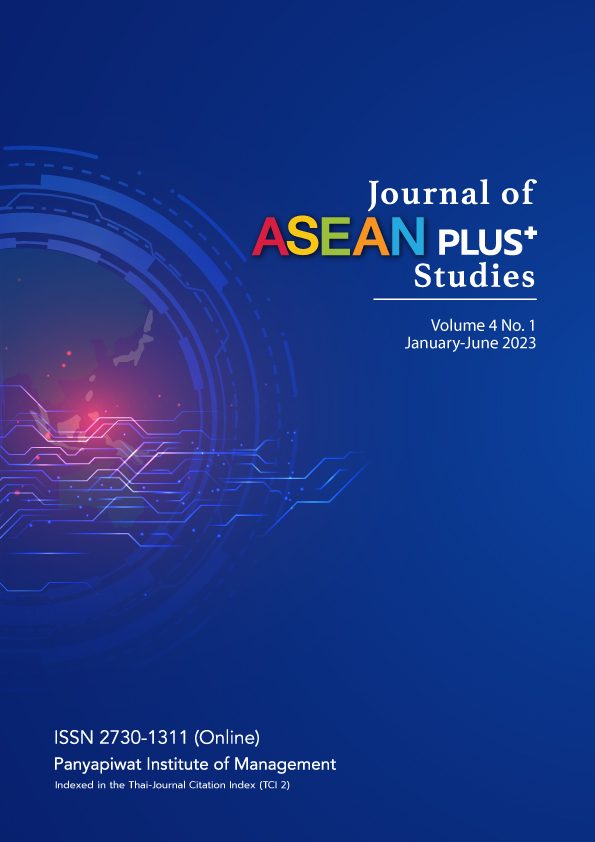
January-June
Vol. 4 No. 1 (2023)Foreword
Two S-Curve Industries in Thailand attracted the research interests of scholars for this issue: “Health Tourism” and “Food for the Future”.
Wilaipan Jaiwilai et al. focuses on “The Promotion of Health Tourism in Thailand with International and Domestic Standards”. The standards they reviewed cover the WellHotel Standards of GHA; STAR Facility Accreditation of GBAC; the standards of WTTC; and the Thai Standards of SHA, followed by recommendations for health tourism-related establishments in Thailand to obtain certification.
China ASEAN Studies, PIM (CASPIM) examines “Food for the Future: Partners & Opportunities in China” in terms of hot spots, current trends, market structure, government regulation, and the ecosystem in the Chinese market of healthcare food. Three business models are proposed based on 8 case studies: outsourcing in China; export of Thai products to China and joint venture. They are related to the broader issue of strategic choices between cooperation parterres based on their identity and incentives.
Another food for the future is discussed by Pithoon Thanabordeekij and Phuwit Kitiya in “Factors Affecting Purchase Intentions of Plant-based Food
Products in Mueang Lampang”. The multiple linear regression reveals that environmental concerns, subjective norms, and perceived consumers' effectiveness factors affect the purchase intention of plant-based food products in this less-developed area of Thailand.
Other scholars in this issue extend their vision to ASEAN neighbors in Lao PDR and Cambodia, exploring traditional sectors like agriculture as well as new areas like e-commerce through social media and cryptocurrency.
Chairat Burana et al. look at “Clean Agriculture Development in Lao PDR”. Government statistics, key informant interviews and field observations reveal the advantage of “clean agriculture” or “organic agriculture (OA)” in particular in the country. It is recommended that standards of OA, GAP, SNA, and PEP should be promoted for a bigger domestic and international market.
Synuon Kry and Veerisa Chotiyaputa investigate “The Perception of Cambodian Users Towards Cryptocurrency Exchange Application”. The Unified Theory of Acceptance and Use of Technology 2 (UTAUT2) is applied in the analysis which revealed that habit, performance expectancy, and trust significantly influenced the adoption.
A similar TAM Model is also applied by Vorleak Chandara et al. in “Factors Influencing Behavioral Intention to Purchase Online On Facebook Platform: A Case Study in Phnom Penh City”, in which they found perceived usefulness, perceived ease of use, brand ambassador, and electronic word of mouth had positive and significant effects on behavioral intention.
Prof. Dr. Tang Zhimin
Editor-in-chief
-
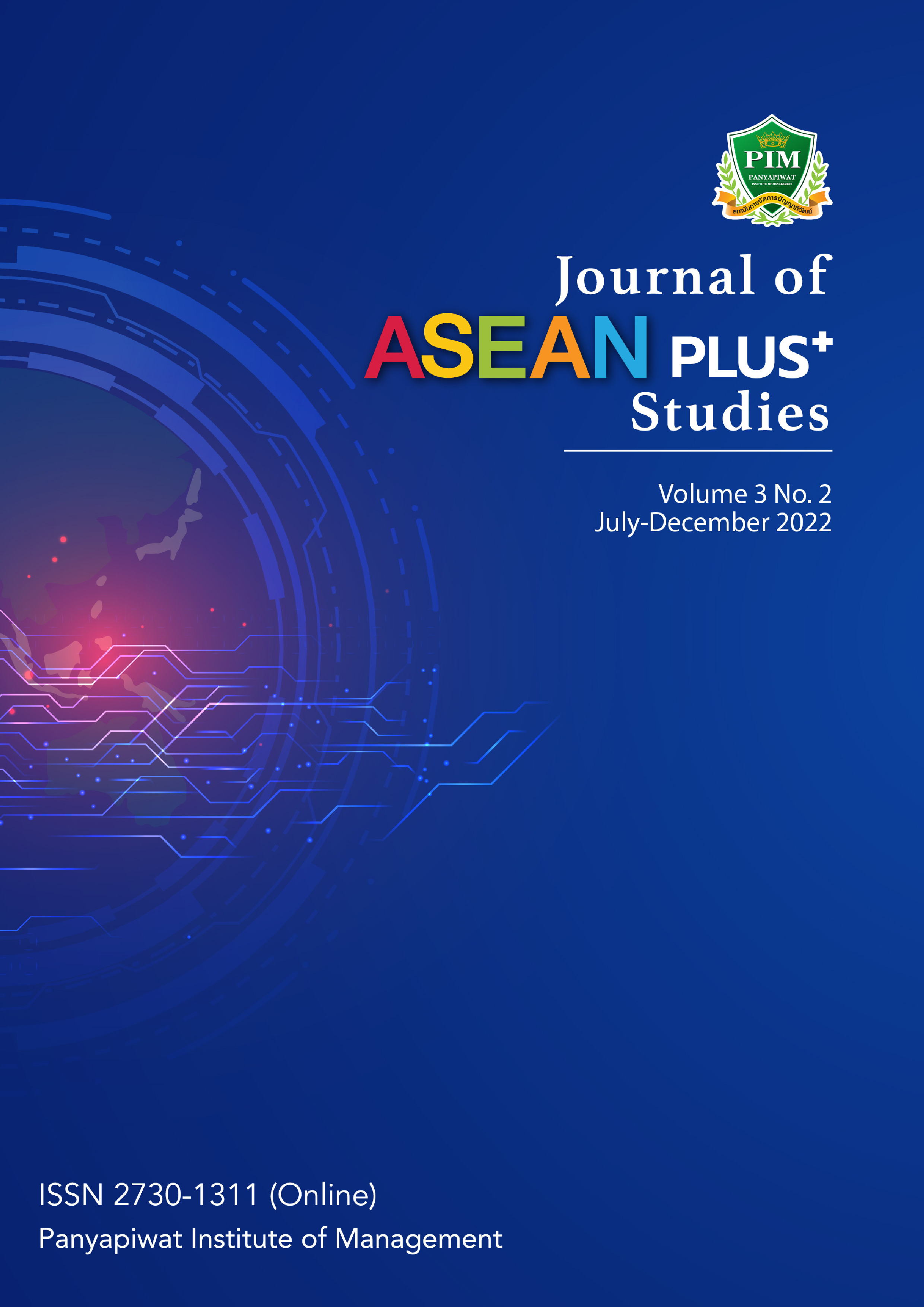
July-December
Vol. 3 No. 2 (2022)ForewordIn the last month of 2022, China announced the earlier-than-expected end to COVID curbs. During the days of stringent Zero COVID Policy and frequent lockdown, some China watchers ponder the possibilities of the country reverting to the pre-reform era. Waroonporn Suwanthanin from PIM offers a historical perspective on “Closed-Door Policy of the Qing Dynasty”. It reviews how the policy was initiated and implemented, its political and economic impacts, and the lessons for China today.
COVID-19 may also trigger the transformation of organizations with the novel mode of life and work. Kyoko Kato from Shibaura Institute of Technology (SIT) in Japan studies the “Impact of Work-From-Home (WFH) under COVID-19 and the Changes in Work-Life- Balance (WLB) Attitude”, based on in-depth interviews with a group of Japanese male workers.
The pandemic may also create new opportunities for entertainment industries. Danai Tanmee and his team from Srinakharinwirot Univesity and Chiangmai University venture into the “Video Streaming in Thailand”. They scrutinize the activities of Generation Z during the pandemic and get insights on their brand awareness, perceived quality, perceived price fairness, and subscription intention.
The APEC Summit 2022 also brought the international limelight on the Bio-Circular-Green Economic Model (BCG) of Thailand. Kritsana Lakkhongkha from Sripatum University delivers a timely report on “Green Marketing in ASEAN”. It discusses the economic, political, legal, technological, and environmental context for green marketing in ASEAN, and suggests the concepts of eco-marketing and green products.
Economic integration and cross-cultural exchange in ASEAN plus countries may also impact the marketing mix for consumer products. Pithoon Thanabordeekij et al. from Chiang Mai University find the role of “Korean Wave” on Korean Food Consumption in Thailand, while Chetana Chey and Sunida Piriyapada from PIM discover the “Influence of Celebrity Endorsement” on purchase intention of smartwatches in Phnom Penh Cambodia, given the suitable celebrity credibility, celebrity attractiveness, and product match-up.
Prof. Dr. Tang Zhimin
Editor-in-chief
-
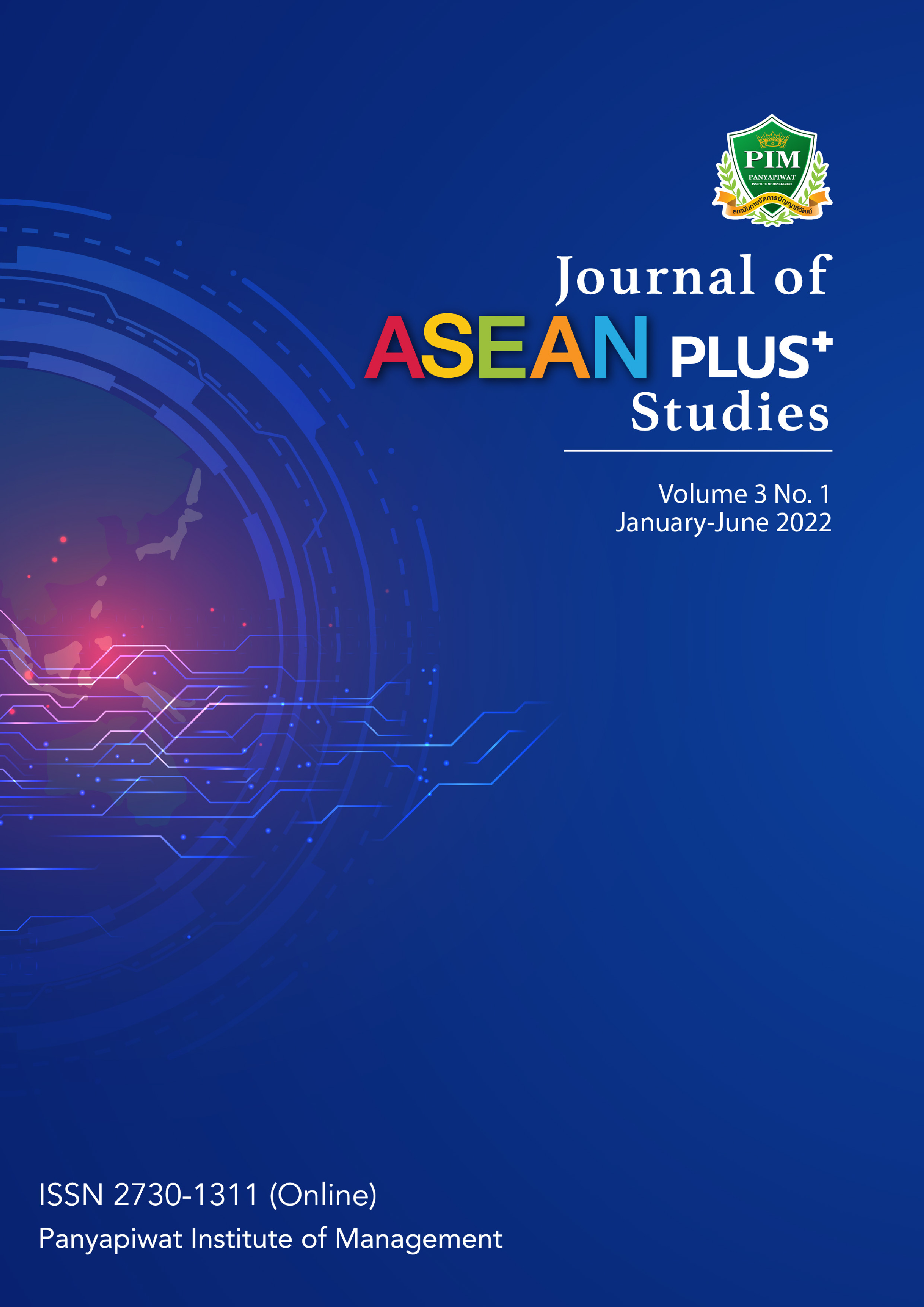
January-June 2022
Vol. 3 No. 1 (2022)Foreword
As the Journal of ASEAN PLUS+ Studies celebrates its third anniversary, its position as a platform for publishing academic research with a focus on government policy, business practice, and cultural development in ASEAN and its partners becomes well received by its readers and contributors. The central role of ASEAN in the region for economic recovery, political stability, and inclusive development is one of the contributing factors to a wider readership of the journal.
China ASEAN Studies, PIM (CASPIM) contributes a paper based on its year-long research sponsored by the National Research Council of Thailand (NRCT) and the Knowledge Network Institute of Thailand (KNIT). Not only it touches a timely topic of Thai fruits export to China with challenges of logistic breakdown under Chinese ZCP (Zero Covid Policy), it also makes an academic contribution with the concept of “Supply Chain Integration” (SCI) as the key strategy to achieve a “Demand-Driven Supply Chain” (DDSC), with a 5i framework (information, Initiation, interconnection, inspection, and investment).
From a geostrategic perspective, Kan Yuenyong, a Ph.D. candidate in NIDA and Charoenchai Chaipiboolwong, discusses the concept of ASEAN Centrality evolved since 2011 in various definitions, especially under challenges from the contest of power between the US and China in Indo-Pacific. They conclude that for Thailand, ASEAN Centrality will be impelled toward a more unified ASEAN similar to the platform of the European Union.
Wilaipan Jaiwilai of NIDA and Wipada Kunaviktikul, a Professor & Vice President in Health Science Affairs of PIM, investigate the decline in wellness tourists caused by the COVID-19 pandemic to determine the most effective strategy and best practices to re-start the industry once the pandemic subsides. They use Thailand as a case study because of the country’s strong potential and its effort to rebrand the country from a low-cost to a high-value destination.
With a quantitative approach, Chanatip Suksai tests how logistics performance could influence the trade flows between Thailand and China. The Thai government is advised to enhance the logistics performance with improvements in physical infrastructure, shipment process, and customs procedures to accommodate the increasing demand for international trade.
In retailing business, Akaraphun Ratasuk discusses the contributions of product quality, service quality, store ambiance, and promotion on customer loyalty, mediated by brand identity with the data of convenience store coffee chains in Bangkok, while Li Zhi and Apirada Chinprateep reveal “New Retail” is the business model positively enhances customer value, based on the investigation on customers of a supermarket in China
Prof. Dr. Tang Zhimin
Editor-in-Chief
-
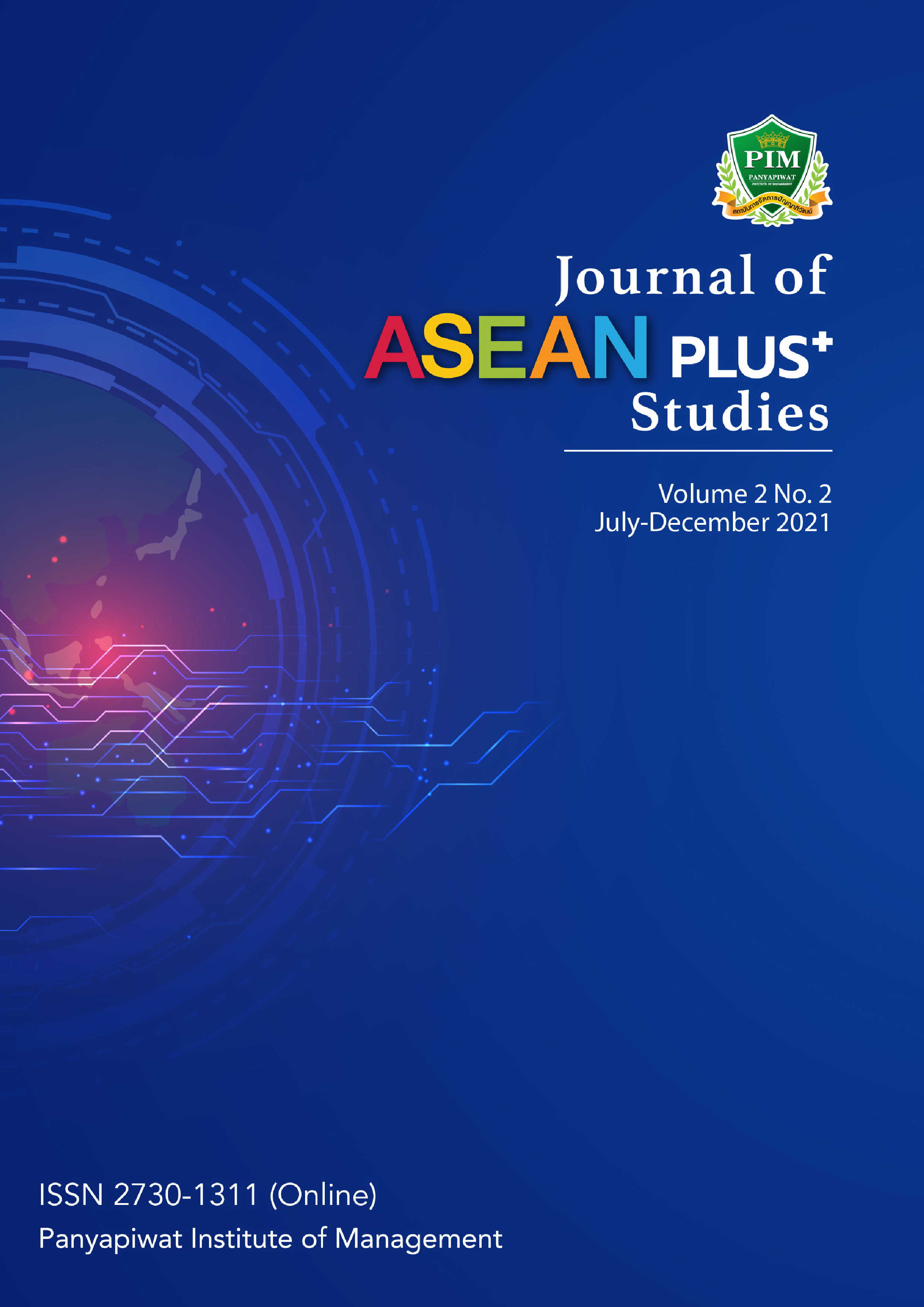
July-December 2021
Vol. 2 No. 2 (2021)Foreword
The year 2021 witnesses the intensified China-USA rivalry in ASEAN. The authors from China ASEAN Studies of PIM (CASPIM), one of the most active think-tanks on China ASEAN in the country, draw the timeline of engagement between ASEAN and the two superpowers, compare their achievements in trade and investment, and speculate on China’s response in its Belt & Road Initiative (BRI) in the region. Covid 19 is another driver for change in ASEAN. Varaporn Klayprayong reviews how ASEAN dealt with the crisis in the past two years and ponders on how experiential learning should be adapted in terms of its internal and external environment when online learning becomes a norm during the pandemic. People and organizations are compelled to change in extreme uncertainties. Kyoko Kato et al. conducted a case study in Japan on an innovative method to develop management skills with a training session using percussion instruments (Drum Circle). They record and analyze the process, contents, and impacts of applying such a method in a workshop named “Team building with rhythm” for an innovative workplace. Nisha Nipasuwan et al. review extensively the literature on “learning to learn” in learning organizations and its impacts on employability for the future. A complimentary survey of HR professionals in listed companies in Thailand shows the gap and potential in “learning & development”. For changes at the operational level, Kritsana Lakkhongkha et al. acknowledge the increasing demand for logistics in ASEAN as a result of economic growth and expansion of e-commerce and suggest companies should integrate their marketing mix with the logistic and supply chain management, aided by new technologies. Isabella Wambui Kiranga et al. examines the factors affecting technology adoption in the mobile banking sector in Kenya, with a UTAUT model in terms of “performance expectancy”, “effort expectancy”, “social influence”, “facilitating conditions” and “culture”.
Prof. Dr. Tang Zhimin
Editor-in-chief
-
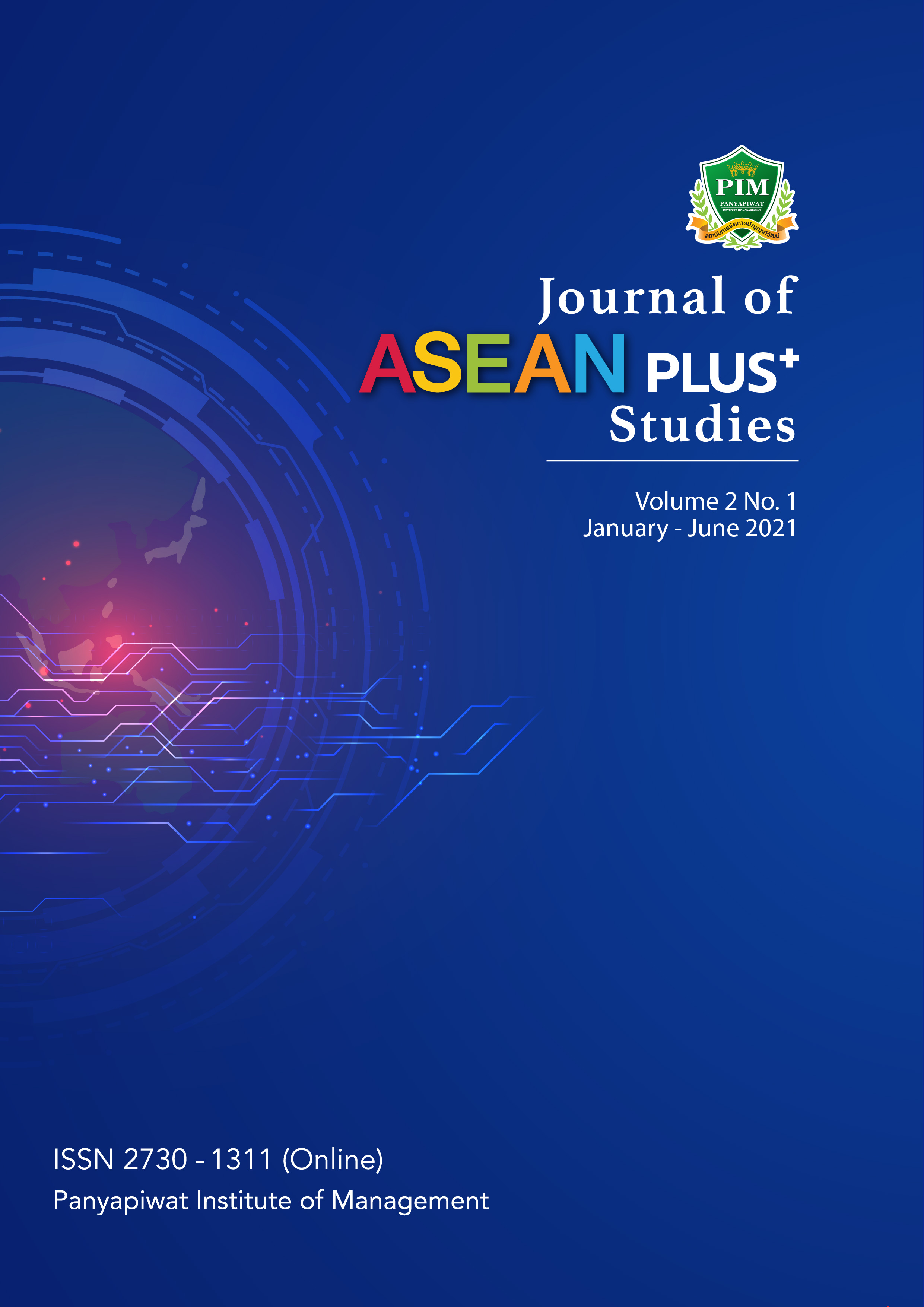
January - June 2021
Vol. 2 No. 1 (2021)Foreword
The response of economy and business of ASEAN plus countries to COVID-19 pandemic and digital transformation is the major theme of this first issue of 2021. The new rounds of COVID-19 pandemic raised the concern of rising poverty in ASEAN countries. The authors from China ASEAN Studies of PIM (CASPIM) compare the poverty alleviation experiences of China and Thailand in terms of apparent situations, measurement and actions, as well as impacts of the pandemic and Innovations in digital and green economy. Anupong Avirutha investigates digitalization of ASEAN: opportunities for growth and innovation, challenges from digital literacies, and strategy development. Digital transformation also brings profound changes in business model and marketing practice. Based on their observations in Thailand, several authors contribute to the theoretical development in areas of Value-Based Pricing (Prapasri Phongthanapanich and Wisanan Ouparamai); and New Business Models for Innovative Business (Kritsana Lakkhongkha). On the empirical front, Pithoon Thanabordeekij et al. reviews the telecom industry in Thailand and identifies the gap in customer expectations and perceptions for one operator, while Thanawadi Theerakulvanich and Veerisa Chotiyaputta reveal purchase intentions in the nighttime economy in cases of nightclubs and bars in urban Bangkok.
Prof. Dr. Tang Zhimin
Editor-in-Chief





